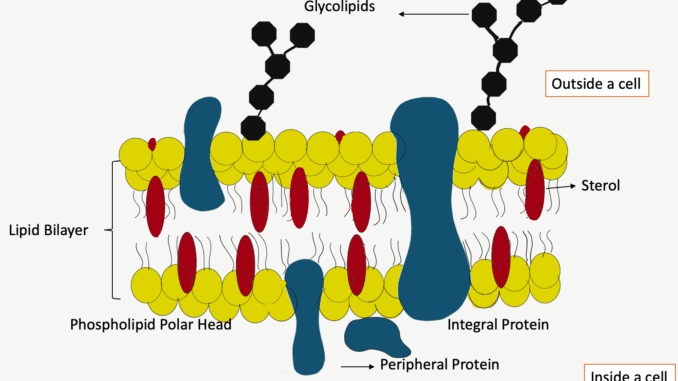
Definition
A plasma membrane is defined as a covering or envelope which encloses almost all types of cells whether it is plant or animal. It is also known as the cell membrane, cytoplasmic membrane, or cell or plasma lamella. The term Cell membrane was coined by Nageli and Carmer in 1855.
Composition of plasma membrane
Lipids
There are four major classes of lipids in the plasma membrane namely
Phospholipids
It is the principal component of the cell membrane having two hydrocarbon chains of fatty acids joined to a polar head group containing phosphate.
Phospholipids are further composed of
Phosphatidylcholine
Phosphatidylethanolamine
Phosphatidylserine
Sphingomyelin
Phosphatidylinositol (inner membrane in minor quantity used for cell signaling )
These compounds make up more than half of the lipid membranes. They are distributed between the two halves of the bilayer membrane. The diagrammatic description is as follows
Phospholipid Structure
The head groups of both phosphatidylserine and phosphatidylinositol are negatively charged, so their predominance in the inner leaflet results in a net negative charge on the cytosolic face of the plasma membrane.
Sphingolipids
Sphingolipids have molecules of amine alcohol instead of glycerols and are found abundantly in the cells of the brain. The myelin sheath of the nerve fibers contains a lipid known as sphingomyelin which contains sphingosine and phospholipids in its molecules.
Glycolipids
Carbohydrates and lipids are the main components of glycolipids. The glycolipids are further divided into two kinds in animal cells these are
Cerebrosides: As the name suggests it makes the white matter of the brain and myelin sheath of nerves
Ganglioside: It acts as an antigen in the body. The grey matter of the brain, erythrocytes are mainly formed from gangliosides.
Sterols
Cholesterol is the major sterols present in the membrane of the animal cells. Cholesterol is mainly present inserted into the lipid bilayer with its polar hydroxyl group close to the phospholipid head groups. Depending on the temperature, cholesterol has distinct effects on membrane fluidity
Proteins
The main function of protein in the plasma membrane is to carry specific membrane functions. The density of protein and lipids in the plasma membrane is about 50 percent each and carbohydrate is around 5-10%.
Proteins in the plasma membranes are classified under two main categories based on their position
- Integral or intrinsic proteins
- Peripheral or extrinsic proteins
The intrinsic proteins are associated strongly with the membranes in comparison to peripheral proteins.
On the basis of functions, proteins are categorized into three classes
- Structural proteins
- Enzymes
- Transport proteins
The mainframe or bulk of the plasma membrane is formed by the structural proteins. Enzymes are ecto and endo in nature. Transport protein helps in the transportation of specific substances across the membrane.
Carbohydrates
Carbohydrates are present in the plasma membrane in the form of short-branched or unbranched chains of sugars known as oligosaccharides. The carbohydrates that are attached to the protein part are known as glycoproteins and carbohydrates which are attached to the polar ends, or lipid parts are known as glycolipids.

